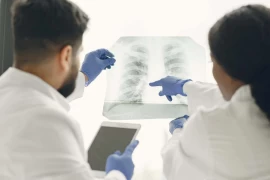
Pneumothorax (Lung Deflated)
- Pneumothorax (Lung Deflated)
- What is Lung Deflate?
- What are the Conditions that Cause Lung Extinction?
- What are the Prevention Methods from Lung Depletion?
- What are the Treatment Methods for Lung Decay?
What is Lung Deflate?
Lung collapse is a condition medically known as a pneumothorax. It occurs when there is an abnormal accumulation of air in the chest cavity, a space where the lungs normally fill and expand with the air they contain. In this condition, the lung cannot perform its normal function and the affected person may experience symptoms such as difficulty breathing, chest pain and shortness of breath.
What are the Conditions that Cause Lung Extinction?
Lung collapse (pneumothorax) can often be associated with:
Traumatic injuries: As a result of a traumatic event such as a rib fracture, chest trauma or a penetrating wound, the pleura may be injured and pneumothorax may occur.
Lung diseases: Some lung diseases can increase the risk of pneumothorax. Conditions such as chronic obstructive pulmonary disease (COPD), cystic fibrosis, and lung fibrosis may increase the likelihood of developing pneumothorax.
Lung surgeries: During lung surgeries, pneumothorax may occur as a result of injury or surgical intervention in the operating area.
Spontaneous pneumothorax: It is a pneumothorax that occurs spontaneously without a known cause. It is more common in young, slender, smokers.
Medication use: In rare cases, some medications can increase the risk of pneumothorax. Especially some cancer drugs and inhalers can cause pneumothorax.
Marfan syndrome: Some genetic diseases, such as Marfan syndrome, can increase the risk of pneumothorax.
Pneumothorax can occur at any age, but is usually more common in young adults and men.

What are the Prevention Methods from Lung Depletion?
You can take the following precautions to prevent lung collapse:
Do not smoke: Smoking can increase the risk of lung diseases and pneumothorax. If you smoke, it's important to quit as soon as possible. Be mindful of being in a non-smoking environment as well, as secondhand smoke can also be harmful.
Avoid traumas: Chest traumas can increase the risk of pneumothorax. To ensure safety, wear your car belt, wear protective equipment during sports, and avoid risky activities.
Use medications correctly: Some medications can increase the risk of pneumothorax. Use these drugs in the right dosage and according to your doctor's instructions. If you are on medication and develop symptoms such as pneumothorax, contact your doctor immediately.
Manage underlying diseases: If you have underlying lung diseases such as chronic obstructive pulmonary disease (COPD), follow your treatment plan regularly and follow your doctor's recommendations. Thus, it can be ensured that your disease is kept under control and the risk of pneumothorax is reduced.
Be mindful: Being mindful during activities or in daily life can reduce the risk of pneumothorax. Exercise caution and wear protective equipment when necessary, especially in high-risk sports or physical activities.
Healthy lifestyle: Leading a healthy lifestyle improves your overall health and supports your lung health. Eat a balanced diet, exercise regularly, stay away from stress and go to regular health checkups.
These measures can help reduce the risk of pneumothorax. However, pneumothorax may not always be completely prevented.
What are the Treatment Methods for Lung Decay?
Lung collapse (pneumothorax) treatment methods may vary depending on the severity of the pneumothorax, the risk of recurrence and the general health of the person. Here are some of the pneumothorax treatment methods:
Observation: In cases of minor and asymptomatic pneumothorax, observation is generally preferred. The air accumulation usually resolves on its own and the lungs return to normal. However, it is important to follow the patient closely.
Aspiration: In cases of minor pneumothorax, air can be aspirated (aspiration) by inserting a needle into the chest cavity to reduce air accumulation. This process helps expand the lung and can contribute to alleviation of symptoms.
Thoracostomy or thoracocentesis: In cases where the pneumothorax is greater or symptomatic, a thoracostomy or thoracocentesis is usually performed. In this procedure, a tube is inserted into the chest cavity and air is evacuated. The tube can be left in place for a period of time to remove air build-up.
Pleurodesis: When pneumothorax becomes a recurrent or persistent problem, a surgical procedure called pleurodesis may be considered. In this procedure, the pleural layers that are attached to the outer surface of the lung are adhered to each other and the recurrence of pneumothorax is prevented.
Surgical repair: In some cases, surgical intervention may be required, especially in cases of recurrent pneumothorax or large pneumothorax. Surgical repair may involve repairing or strengthening the lung, depending on the cause of the pneumothorax.
The treatment approach may vary depending on the cause of the pneumothorax, the patient's symptoms and general health. A healthcare professional will assess your condition, determine the right treatment option, and recommend the treatment that is right for you.





